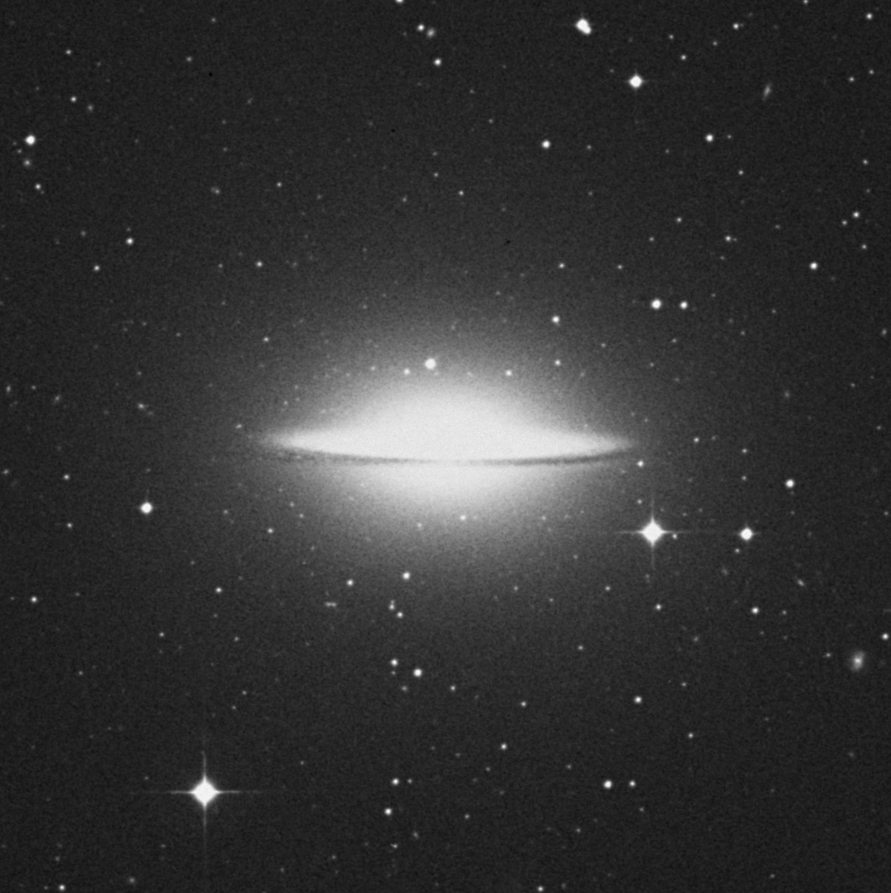Object Name: Messier 104
Alternative Designations: M104, NGC 4594, The Sombrero Galaxy
Object Type: Type Sa Spiral Galaxy
Constellation: Virgo
Right Ascension: 12 : 40.0 (h:m)
Declination: -11 : 37 (deg:m)
Distance: 50000 (kly)
Visual Brightness: 8.0 (mag)
Apparent Dimension: 9×4 (arc min)
Locating Messier 104: M104 is easily found exactly 11 degrees – about a fistwidth – due west of Alpha Virginis (Spica). With excellent conditions from a dark sky site, it can be spotted in binoculars as a small, eye-shaped patch of nebulosity. With telescopes as small as 3″ in aperture, it takes on a galactic signature and reveals its dark dustlane beginning at about 4.5″ in aperture. The more light gathering ability, the more the beautiful Sombrero Galaxy reveals! As always, galaxies prefer dark sky sites and good seeing conditions.
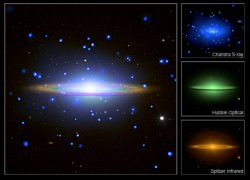 What You Are Looking At: The Sombrero, also known as M104, is one of the largest galaxies in the nearby Virgo cluster, about 28 million light years from Earth. This Great Observatories view of the famous Sombrero galaxy was made using NASA’s Chandra X-ray Observatory, Hubble Space Telescope and Spitzer Space Telescope. The main figure shows the combined image from the three telescopes, while the three inset images show the separate observatory views. The Chandra X-ray image (in blue) shows hot gas in the galaxy and point sources that are a mixture of objects within the Sombrero as well as quasars in the background. The Chandra observations show that diffuse X-ray emission extends over 60,000 light years from the center of the Sombrero. (The galaxy itself spans 50,000 light years across.) Scientists think this extended X-ray glow may be the result of a wind from the galaxy, primarily being driven by supernovas that have exploded within its bulge and disk. The Hubble optical image (green) shows a bulge of starlight partially blocked by a rim of dust, as this spiral galaxy is being observed edge on. That same rim of dust appears bright in Spitzer’s infrared image, which also reveals that Sombrero’s central bulge of stars.
What You Are Looking At: The Sombrero, also known as M104, is one of the largest galaxies in the nearby Virgo cluster, about 28 million light years from Earth. This Great Observatories view of the famous Sombrero galaxy was made using NASA’s Chandra X-ray Observatory, Hubble Space Telescope and Spitzer Space Telescope. The main figure shows the combined image from the three telescopes, while the three inset images show the separate observatory views. The Chandra X-ray image (in blue) shows hot gas in the galaxy and point sources that are a mixture of objects within the Sombrero as well as quasars in the background. The Chandra observations show that diffuse X-ray emission extends over 60,000 light years from the center of the Sombrero. (The galaxy itself spans 50,000 light years across.) Scientists think this extended X-ray glow may be the result of a wind from the galaxy, primarily being driven by supernovas that have exploded within its bulge and disk. The Hubble optical image (green) shows a bulge of starlight partially blocked by a rim of dust, as this spiral galaxy is being observed edge on. That same rim of dust appears bright in Spitzer’s infrared image, which also reveals that Sombrero’s central bulge of stars.
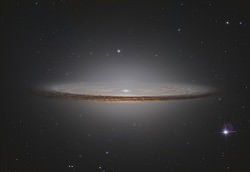 Like “Diamonds on the Hat”, globular clusters are all parcel and part of M104’s makeup. “Images from the Hubble Space Telescope Advanced Camera for surveys are used to carry out a new photometric study of the globular clusters (GCs) in M104, the Sombrero galaxy. The primary focus of our study is the characteristic distribution function of linear sizes [size distribution function (SDF)] of the GCs. We measure the effective radii for 652 clusters with point spread function-convolved King and Wilson dynamical model fits. The SDF is remarkably similar to those measured for other large galaxies of all types, adding strong support to the view that it is a ‘universal’ feature of GC systems. We use the Sombrero and Milky Way data and the formation models of Baumgardt & Kroupa (2007) to develop a more general interpretation of the SDF for GCs. We propose that the shape of the SDF that we see today for GCs is strongly influenced by the early rapid mass loss during their star-forming stage, coupled with stochastic differences from cluster to cluster in the star formation efficiency (SFE) and their initial sizes. We find that the observed SDF shape can be accurately predicted by a simple model in which the protocluster clouds had characteristic sizes of 0.9 ± 0.1 pc and SFEs of 0.3 ± 0.07 .” says Wlliam E. Harris (et al).
Like “Diamonds on the Hat”, globular clusters are all parcel and part of M104’s makeup. “Images from the Hubble Space Telescope Advanced Camera for surveys are used to carry out a new photometric study of the globular clusters (GCs) in M104, the Sombrero galaxy. The primary focus of our study is the characteristic distribution function of linear sizes [size distribution function (SDF)] of the GCs. We measure the effective radii for 652 clusters with point spread function-convolved King and Wilson dynamical model fits. The SDF is remarkably similar to those measured for other large galaxies of all types, adding strong support to the view that it is a ‘universal’ feature of GC systems. We use the Sombrero and Milky Way data and the formation models of Baumgardt & Kroupa (2007) to develop a more general interpretation of the SDF for GCs. We propose that the shape of the SDF that we see today for GCs is strongly influenced by the early rapid mass loss during their star-forming stage, coupled with stochastic differences from cluster to cluster in the star formation efficiency (SFE) and their initial sizes. We find that the observed SDF shape can be accurately predicted by a simple model in which the protocluster clouds had characteristic sizes of 0.9 ± 0.1 pc and SFEs of 0.3 ± 0.07 .” says Wlliam E. Harris (et al).
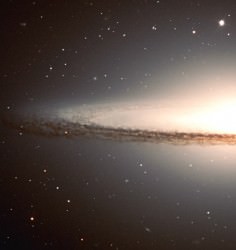 “The colours and luminosities of the M104 clusters show the clearly defined classic bimodal form. The blue sequence exhibits a mass/metallicity relation, following a scaling of heavy-element abundance with luminosity of Z?L0.3 very similar to what has been found in most giant elliptical galaxies. A quantitative self-enrichment model provides a good first-order match to the data for the same initial SFE and protocluster size that were required to explain the SDF. We also discuss various forms of the GC Fundamental Plane of structural parameters and show that useful tests of it can be extended to galaxies beyond the Local Group. The M104 clusters strongly resemble those of the Milky Way and other nearby systems in terms of such test quantities as integrated surface density and binding energy.”
“The colours and luminosities of the M104 clusters show the clearly defined classic bimodal form. The blue sequence exhibits a mass/metallicity relation, following a scaling of heavy-element abundance with luminosity of Z?L0.3 very similar to what has been found in most giant elliptical galaxies. A quantitative self-enrichment model provides a good first-order match to the data for the same initial SFE and protocluster size that were required to explain the SDF. We also discuss various forms of the GC Fundamental Plane of structural parameters and show that useful tests of it can be extended to galaxies beyond the Local Group. The M104 clusters strongly resemble those of the Milky Way and other nearby systems in terms of such test quantities as integrated surface density and binding energy.”
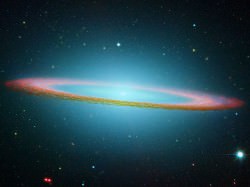 But, just like our own galaxy, globular clusters aren’t all that’s hiding inside that awesome halo. “We used the CTIO 4m telescope to make a complete and kinematically unbiased survey of M104 (NGC 4594; the Sombrero galaxy) for planetary nebulae (i.e., stars) out to 16 kpc. We present the positions and monochromatic [O III] lambda 5007 magnitudes of 294 planetaries, and use the observed planetary nebula luminosity function (PNLF) to measure a distance of 8.9+/-0.6Mpc to the galaxy. The luminosity-specific PN number lambda 2.5 in the halo of M104 is approximately 21.7×10^-9^L_{sun}_, which for its color (B-V)=0.95, is comparable to the values in other galaxies.” says H.C. Ford (et al).
But, just like our own galaxy, globular clusters aren’t all that’s hiding inside that awesome halo. “We used the CTIO 4m telescope to make a complete and kinematically unbiased survey of M104 (NGC 4594; the Sombrero galaxy) for planetary nebulae (i.e., stars) out to 16 kpc. We present the positions and monochromatic [O III] lambda 5007 magnitudes of 294 planetaries, and use the observed planetary nebula luminosity function (PNLF) to measure a distance of 8.9+/-0.6Mpc to the galaxy. The luminosity-specific PN number lambda 2.5 in the halo of M104 is approximately 21.7×10^-9^L_{sun}_, which for its color (B-V)=0.95, is comparable to the values in other galaxies.” says H.C. Ford (et al).
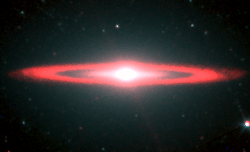 “We use the PNLF distance to M104 to compare its luminosity to the luminosities of the brightest galaxies in the Virgo Cluster, finding that if M104 were in the Virgo Cluster, it would be the third brightest galaxy. We combined the PNLF distance and the observed velocity corrected for Virgo infall to calculate a Hubble constant H_0_=91+/-8km/s/Mpc. We also used the PNLF distances to the NGC 1023 group, the Leo group, the Virgo Cluster, and the Fornax Cluster to derive Hubble constants corrected for Virgo infall. The values of H_0_ for M104, the NGC 1023 group, the Virgo Cluster, and the Fornax Cluster are in excellent agreement, suggesting that the PNLF distances and Schechter’s linear infall model provide a self-consistent representation of the Hubble expansion and Virgo infall within most regions of the local supercluster.”
“We use the PNLF distance to M104 to compare its luminosity to the luminosities of the brightest galaxies in the Virgo Cluster, finding that if M104 were in the Virgo Cluster, it would be the third brightest galaxy. We combined the PNLF distance and the observed velocity corrected for Virgo infall to calculate a Hubble constant H_0_=91+/-8km/s/Mpc. We also used the PNLF distances to the NGC 1023 group, the Leo group, the Virgo Cluster, and the Fornax Cluster to derive Hubble constants corrected for Virgo infall. The values of H_0_ for M104, the NGC 1023 group, the Virgo Cluster, and the Fornax Cluster are in excellent agreement, suggesting that the PNLF distances and Schechter’s linear infall model provide a self-consistent representation of the Hubble expansion and Virgo infall within most regions of the local supercluster.”
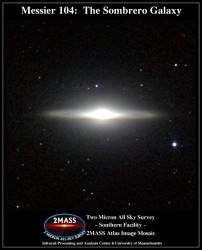 History: Messier 104 was not included in Messier’s originally published catalog. However, Charles Messier added it by hand to his personal copy on May 11, 1781, and described it as a “very faint nebula.” It was Camille Flammarion who found that its position coincided with Herschel’s H I.43, which is the Sombrero Galaxy (NGC 4594), and added it to the official Messier list in 1921. This object is also mentioned by Pierre Mechain as his discovery: “On May 11, 1781, I discovered a nebula above the Raven [Corvus] which did not appear to me to contain any single star. It is of a faint light and difficult to find if the micrometer wires are illuminated. I have compared it [its position] on this day and the following with Spica in the Virgin and from this derived its right ascension 187d 9′ 42″ and its southern declination 10d 24′ 49″ [the same position as in Messier’s handwritten note]. It does not appear in the Connoissance des Temps.”
History: Messier 104 was not included in Messier’s originally published catalog. However, Charles Messier added it by hand to his personal copy on May 11, 1781, and described it as a “very faint nebula.” It was Camille Flammarion who found that its position coincided with Herschel’s H I.43, which is the Sombrero Galaxy (NGC 4594), and added it to the official Messier list in 1921. This object is also mentioned by Pierre Mechain as his discovery: “On May 11, 1781, I discovered a nebula above the Raven [Corvus] which did not appear to me to contain any single star. It is of a faint light and difficult to find if the micrometer wires are illuminated. I have compared it [its position] on this day and the following with Spica in the Virgin and from this derived its right ascension 187d 9′ 42″ and its southern declination 10d 24′ 49″ [the same position as in Messier’s handwritten note]. It does not appear in the Connoissance des Temps.”
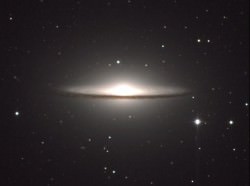 William Herschel found this object independently on May 9, 1784, but it would be his son John who would first notice there was something a bit different about it: “There is a faint diffused oval light all about it, and I am almost positive that there is a dark interval or stratum separating the nucleus and general mass of the nebula from the light above (s of) it. Surely no illusion. There is a faint diffused oval light all about it, and I am almost positive that there is a dark interval or stratum separating the nucleus and general mass of the nebula from the light above (south of) it.”
William Herschel found this object independently on May 9, 1784, but it would be his son John who would first notice there was something a bit different about it: “There is a faint diffused oval light all about it, and I am almost positive that there is a dark interval or stratum separating the nucleus and general mass of the nebula from the light above (s of) it. Surely no illusion. There is a faint diffused oval light all about it, and I am almost positive that there is a dark interval or stratum separating the nucleus and general mass of the nebula from the light above (south of) it.”
Enjoy your observations of this great galaxy!
Top M104 image credit, Palomar Observatory courtesy of Caltech, M104 Composite – Spitzer, Chandra and Hubble, M104 Hubble Remix, M104 Hubble Details, M104 Spitzer Image and M104 image courtesy of Todd Boroson/NOAO/AURA/NSF.

